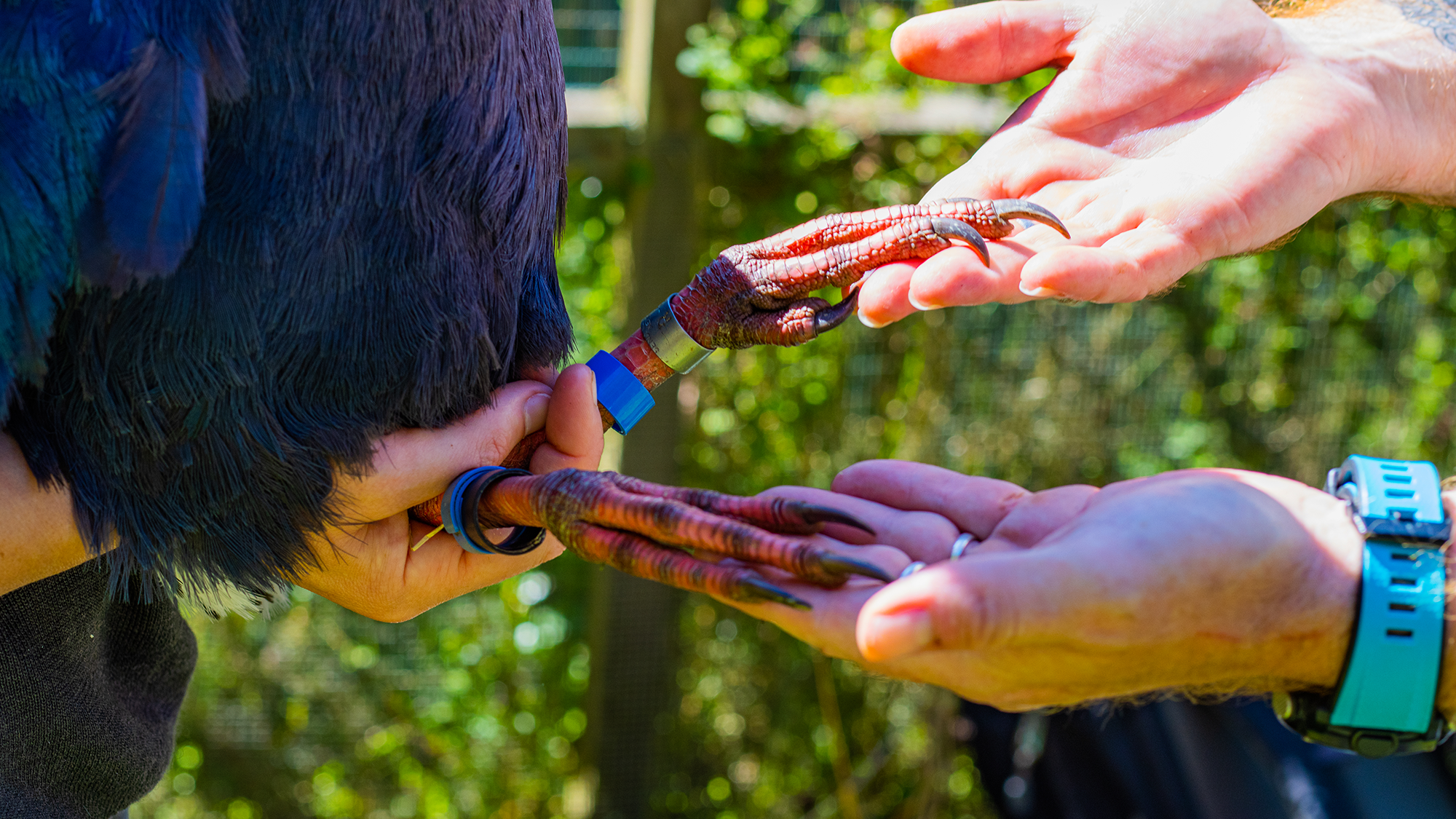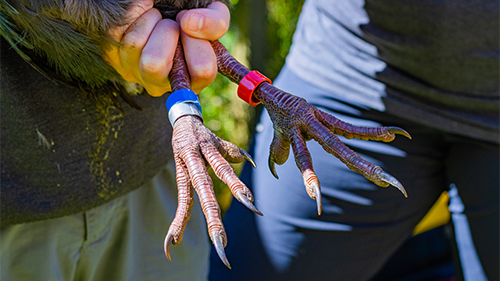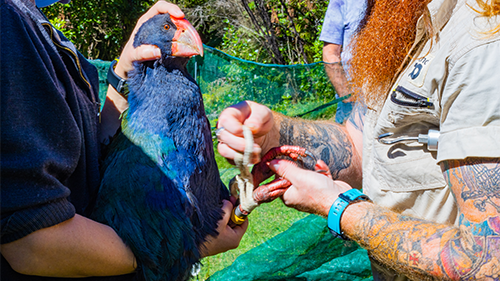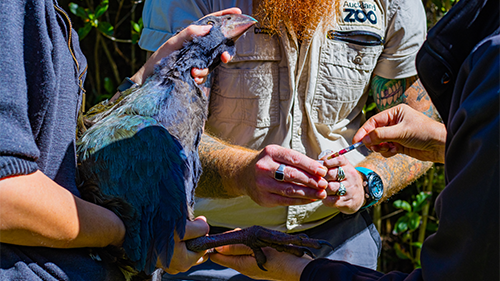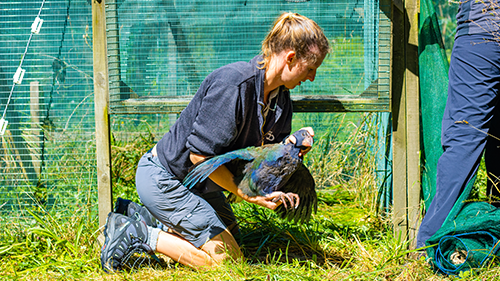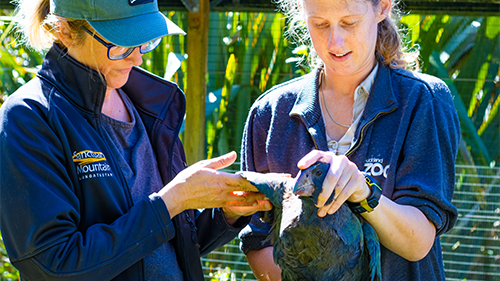 “If juveniles are not in the top ranking for the national programme, they may be released to the wild. They will have tussock training – a bird bootcamp – before being released.”
“If juveniles are not in the top ranking for the national programme, they may be released to the wild. They will have tussock training – a bird bootcamp – before being released.”
- Janelle Ward, biodiversity team leader and wildlife vet, Sanctuary Mountain Maungatautari
Being a takahē doesn’t give you a free pass to be exempt from general health checks.
Sanctuary Mountain Maungatautari breeding pair Hemi and Nancy are familiar with the process of an annual check-up, but it was all new for their 6-month-old chick, who got its first jabs earlier this month. After having had blood samples taken and being vaccinated against erysipelas, a skin infection known to kill takehē, the brave wee bird, who has yet to be named and sexed, was back under the wings of its parents.
Janelle Ward, biodiversity team leader and wildlife vet at Sanctuary Mountain Maungatautari, says the takahē chick will have another vaccine against erysipelas in a month’s time and then a final booster a year later.
“We have our takahē health checks done all at once to keep an eye on the families, and our catch process is designed to minimise stress.”
For the two adult breeding pairs at Maungatautari, a check-up involves being weighed and having the condition of their feathers, eyes, feet and legs checked.
The health checks were done by Auckland Zoo bird keepers Devon Nicholls and Chris Steele, who are specially trained to carry out the health checks and do so at six North Island sites on behalf of the Department of Conservation (DOC), Ngāi Tahu and the Takahē Recovery Programme.
Devon says with just over 400 takahē remaining in the world, each bird is precious. “Obtaining a really comprehensive update on each bird’s health and condition ultimately helps ensure each individual bird has the very best chance to thrive and reproduce successfully.”
Takahē were presumed extinct for nearly 50 years before being famously rediscovered in Fiordland’s Murchison Mountains in 1948. A takahē breeding programme was established to help with their recovery.
The results of the health checks of the Maungatautari takahē will be given to the Takahē Recovery Programme, based in Te Anau. The blood samples taken from the chick will determine its sex and whether it will be included in the breeding programme as an adult, depending on its genetic diversity ranking.
“If juveniles are not in the top ranking for the national programme, they may be released to the wild. They will have tussock training – a bird bootcamp – before being released,” says Janelle. Most of the takahe released in the wild are released at Murchison Mountains.
Sanctuary Mountain Maungatautari is one of 10 locations in New Zealand with active breeding pairs of takahē, and more 25 juvenile takahē have been raised there in the last 10-12 years. The takahē population grows slowly compared to other birds because they have only one or two chicks per year, however, they can live up to 22 years in sanctuaries and will have many breeding seasons in their lifetime. The latest release of birds from the breeding programme has been the largest to date, and it is hoped the takahē population will reach 500 this year.
Community education is one way to achieve the population goal. At Maungatautari, that means holding tours to allow visitors see takahē families up close in their haven at Tautari Wetland.
Devon says learning about takahē is important to grow an appreciation and love for these unique and incredibly special birds. “Communities can help further by supporting and volunteering for organisations and community groups that are helping to remove predators from takahē habitats.”
Takahē are just one of many native species that the 47-kilometre predator-proof fence around Maungatautari protects. To date, 14 species, including hihi (stitchbird), kākā, North Island brown kiwi, kōkako, tīeke (saddleback) and tītipounamu (rifleman), have been reintroduced to the mainland ecological island.
Waikato Regional Council has supported this work for a number of years through its Natural Heritage Fund. The most recent grant of $1.47 million over four years was approved in 2022.
“The Natural Heritage Fund is important,” says Janelle. “The funding we get from the council helps pay for our biggest running cost: keeping the sanctuary’s fence intact; keeping our native species within the fence safe from predators. It makes us one of the reasons that we can hold takahē safely in on the mainland.”
The purpose of the Natural Heritage Fund is to help implement the council’s commitment to preserving the natural heritage of the region – native plants and animals, threatened ecosystems, outstanding landscapes and the natural character of waterways and the coast.
Natural heritage projects are designed to protect and enhance the ecological assets for the people of the region.
The Natural Heritage Fund has been in place since 2005 and is derived from the Natural Heritage targeted rate of $5.80 per annum for each property.



